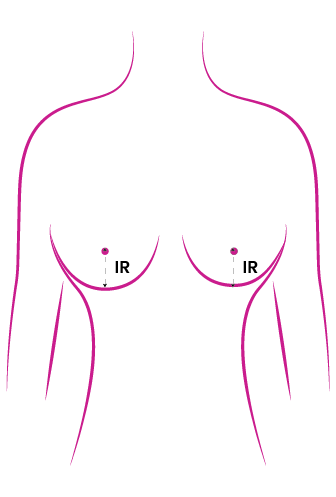There are 2 calculators on this page. The first is the easy one, and the second is the advanced one.
Easy Breast Weight Calculator
Top Pick
Adapt to your baby’s sleep style with this 3-way adjustable swaddle, trusted by hospitals. Easy diaper changes, room for kicking, and safe sleep design. Learn more!
View on Amazon12/20/2024 05:44 pm GMT
This is based on the estimations on this Wikipedia page.
Formula used
Advance Breast Weight Calculator (More Accurate)
Best Moisturizer
Daily Repairing Cream: 3.52 Oz, Lightweight Moisturing Cream for Soft, Glowy Skin, Korean Skin Care, Korean Moisturizer Face Cream
$18.99 on Amazon
Buy Now12/20/2024 11:53 am GMT
Calculating Breast Weight involves two main components:
- Determining Breast Volume
- Calculating Breast Density
The method used in this calculation incorporates these two procedures. While the first part (volume calculation) is generally accurate, the second part relies on estimation.
As a result, the calculation may vary significantly, possibly deviating substantially from the actual weight of the breast.
For the first part of the calculation, we employed the anthropometric formula established by Qiao et al. This formula has been extensively utilized and validated through numerous research studies.
The second part involves the calculation of breast density. Breast density cannot be physically measured, and it may not even be determinable through touch; this is the most challenging aspect of the calculation.
As mentioned earlier, to obtain an accurate measurement of density, a mammogram is required. However, for those who cannot undergo this procedure, it is possible to make an estimate based on a range of values derived from research conducted by Ragip Kayar, Serdar Civelek, Murat Cobanoglu, Osman Gungor, Hidayet Catal, and Mustafa Emiroglu.
For the density input, you have the option to select an estimate. If you have undergone a medical procedure, it is easier for you to determine your breast density.
When breast density is known, the calculation becomes closer to achieving accuracy.
How to Calculate Breast Weight
Calculating breast weight is not a straightforward process. Unlike measuring any other body part while trying to make a cloth.
This is because the breast is made up of both tissues and fats.
To determine breast weight you need to calculate 2 parameters.
- Breast Volume
- Breast Density
How to Calculate Breast Volume
Several Methods have been developed for calculating breast volume. We’ll go over 5 of them namely Anthropometry, Water displacement (Archimedes), Mammography, Grossman-Roudner Device, and Casting Technique.
1. Anthropometry
Anthropometry involves measuring the circumference of the breast at different points. This method is relatively simple and inexpensive. This can be done at home with a simple measuring tape.
You just need to measure some parts of the breast. Here are the needed measurements.
- Mammary Projection (MP)
- Medial Breast Radius (MR)
- Lateral Breast Radius (LR)
- Inferior Breast Radius (IR)
12/18/2024 11:33 am GMT
How to Measure Mammary Projection (MP)
Before we talk about taking the measurement, let’s talk about what the mammary projection is.
What is Mammary Projection?
Mammary projection is the distance from your chest wall to your nipple when you look at it from the side. Imagine you have a clear view of your breast from the side, and you want to know how far your nipple sticks out from your chest. That distance is what we call mammary projection. It’s a simple way to measure how much your breast sticks out.
Here is a demonstration of what it is.

To measure mammary projection using the anthropometry method, you will need a measuring tape and a caliper. You can find measuring tapes at most drugstores or online retailers. For accurate measurement, you need someone to help you.
Step-by-step instructions:
- Stand up straight with your arms at your sides.
- Place the measuring tape around your chest wall, directly below your breasts.
- Take a deep breath and hold it.
- Measure the distance from the nipple to the chest wall.
It is important to note that anthropometric measurement of mammary projection can be less accurate than imaging measurement. If you need an exact value for your measurement, you should use an imaging method such as mammography or breast MRI.
How to Measure Medial Breast Radius (MR)
What is the Medial Breast Radius?
The distance between the nipple and the medial terminal crest represents the radius of the breast tissue extending from the nipple towards the chest wall in the direction of the sternum (midline). It essentially measures how far the breast extends from the nipple toward the center of the chest.
See the diagram below.

Here are step-by-step instructions on how to measure the medial breast radius:
Note: It’s often more accurate to have someone assist you with this measurement.
Tools Needed:
- A flexible measuring tape (in centimeters or inches) or a ruler.
- A mirror may be helpful for self-measurement.
Steps:
- Preparation:
- Ensure that the breast you are measuring is exposed and that you are comfortable.
- Stand or sit in front of a mirror if available to help you locate the nipple and the point on the medial side of the breast.
- Locate the Nipple:
- Identify the nipple on the breast you wish to measure. The nipple is typically a raised, circular area at the center of the breast.
- Identify the Medial Point:
- Visualize an imaginary line extending from the nipple toward the center of the chest, following the inner or medial side of the breast.
- Along this line, identify the point where you want to measure the medial breast radius. This point should be along the path between the nipple and the breastbone (sternum).
- Measurement:
- Using a flexible measuring tape or ruler, gently place one end at the center of the nipple (the base of the nipple).
- Extend the measuring tape or ruler along the imaginary line toward the point you identified on the inner side of the breast.
- Ensure that the measuring tape or ruler is flat against the breast, following the curve.
- Take the measurement in either centimeters or inches, depending on your preference.
- Record the Measurement:
- Once you’ve taken the measurement, note the distance in centimeters or inches. This measurement represents the medial breast radius.
- Repeat if Necessary:
- If you want to measure the medial breast radius for the other breast, repeat the steps on that side as well.
- Documentation:
- It’s a good practice to record the measurement for future reference, especially if you are using it for breast health monitoring or surgical planning.
Remember that breast measurements can vary among individuals and may change over time due to factors like age, hormonal changes, and pregnancy. If you have specific concerns about your breast health or are using these measurements for medical purposes, it’s advisable to consult with a healthcare professional for accurate assessment and guidance.
How to Measure Lateral Breast Radius (LR)
The lateral Breast Radius is the distance from the nipple to a point along the outer or lateral side of the breast, typically toward the underarm (axillary region).
The lateral breast radius is similar to the medial breast radius but the measurement goes to the opposite side of where that of the medial radius goes.
See the diagram below.

Here are step-by-step instructions on how to measure the lateral breast radius:
Note: It’s often more accurate to have someone assist you with this measurement.
Tools Needed:
- A flexible measuring tape (in centimeters or inches) or a ruler.
- A mirror may be helpful for self-measurement.
Steps:
- Preparation:
- Ensure that the breast you are measuring is exposed and that you are comfortable.
- Stand or sit in front of a mirror if available to help you locate the nipple and the point on the lateral side of the breast.
- Locate the Nipple:
- Identify the nipple on the breast you wish to measure. The nipple is typically a raised, circular area at the center of the breast.
- Identify the Lateral Point:
- Visualize an imaginary line extending from the nipple toward the outer or lateral side of the breast, heading toward the underarm (axillary region).
- Along this line, identify the point where you want to measure the lateral breast radius. This point should be along the path between the nipple and the outer edge of the breast.
- Measurement:
- Using a flexible measuring tape or ruler, gently place one end at the center of the nipple (the base of the nipple).
- Extend the measuring tape or ruler along the imaginary line toward the point you identified on the outer side of the breast.
- Ensure that the measuring tape or ruler is flat against the breast, following the curve.
- Take the measurement in either centimeters or inches, depending on your preference.
- Record the Measurement:
- Once you’ve taken the measurement, note the distance in centimeters or inches. This measurement represents the lateral breast radius.
- Repeat if Necessary:
- If you want to measure the lateral breast radius for the other breast, repeat the steps on that side as well.
- Documentation:
- It’s a good practice to record the measurement for future reference, especially if you are using it for breast health monitoring or surgical planning.
Remember that breast measurements can vary among individuals and may change over time due to factors like age, hormonal changes, and pregnancy. If you have specific concerns about your breast health or are using these measurements for medical purposes, it’s advisable to consult with a healthcare professional for accurate assessment and guidance.
How to Measure Inferior Breast Radius
The Inferior Breast Radius is the distance from a point on the lower part of the breast (typically near the inframammary fold, where the breast meets the chest wall) to the nipple.

Note: It’s often more accurate to have someone assist you with this measurement.
Tools Needed:
- A flexible measuring tape (in centimeters or inches) or a ruler.
- A mirror may be helpful for self-measurement.
Steps:
- Preparation:
- Ensure that the breast you are measuring is exposed and that you are comfortable.
- Stand or sit in front of a mirror if available to help you locate the nipple and the point on the lower breast.
- Locate the Nipple:
- Identify the nipple on the breast you wish to measure. The nipple is typically a raised, circular area at the center of the breast.
- Identify the Inferior Point:
- Visualize the lower part of the breast, especially near the inframammary fold. This is the point where the breast meets the chest wall.
- Identify a specific point on the lower breast near the inframammary fold where you want to measure the inferior breast radius.
- Measurement:
- Using a flexible measuring tape or ruler, gently place one end at the base of the nipple (the center of the nipple).
- Extend the measuring tape or ruler vertically downward along the breast’s curve, following the contour of the lower breast, until it reaches the point you identified near the inframammary fold.
- Ensure that the measuring tape or ruler is in contact with the skin and follows the natural curve of the breast.
- Take the measurement in either centimeters or inches, depending on your preference.
- Record the Measurement:
- Once you’ve taken the measurement, note the distance in centimeters or inches. This measurement represents the inferior breast radius.
- Repeat if Necessary:
- If you want to measure the inferior breast radius for the other breast, repeat the steps on that side as well.
- Documentation:
- It’s a good practice to record the measurement for future reference, especially if you are using it for breast health monitoring or surgical planning.
2. Water Displacement (Archimedes)
The Water Displacement method is a technique used to calculate the volume of an object (in this case, the breast) by measuring the amount of water it displaces when submerged in a container of water. Here’s how it works for breast volume calculation:
- A container or tank filled with water is prepared.
- The person undergoing the measurement usually sits or stands in a way that allows their breast to be completely submerged in the water while keeping the rest of their body dry.
- As the breast is submerged, it displaces (pushes aside) some of the water, causing the water level to rise.
- The increase in water level is carefully measured. This increase in water level corresponds to the volume of the breast.
- The volume of water displaced is typically measured in milliliters (mL) or cubic centimeters (cc), which is equivalent.
By measuring the change in water level, it’s possible to calculate the volume of the breast. This method is particularly useful for estimating breast volume for various purposes, including breast health assessments and surgical planning.
Keep in mind that the accuracy of this method depends on the precision of the measurement equipment and the skill of the person conducting the measurement. Additionally, it’s important to ensure that the breast is fully and evenly submerged to obtain an accurate result.
3. Mammography
The Mammography method of calculating breast volume is a technique that uses measurements taken from mammograms to estimate the volume of a woman’s breast tissue. Here’s how it works:
- Mammogram: A mammogram is a specialized X-ray of the breast. During a mammogram, the breast is compressed between two plates and X-ray images are taken from different angles.
- Measurement Parameters: From the mammogram images, specific measurements are taken. These measurements typically include the width (W), height (H), and compression thickness (C) of the breast. These measurements are usually done by a trained technician.
- Volume Calculation: The breast volume is calculated using a formula that incorporates these measurements. The formula commonly used for breast volume estimation is:
Breast Volume (in cubic centimeters or milliliters) = π/4 × W × H × C- π (pi) is a mathematical constant approximately equal to 3.14159.
- W represents the breast width.
- H represents the breast height.
- C represents the compression thickness in the craniocaudal mammogram view.
- Result: The calculated breast volume is typically provided in either milliliters (mL) or cubic centimeters (cc).
The Mammography method is a non-invasive way to estimate breast volume and is often used in medical settings for various purposes, such as assessing breast health, planning breast surgeries, or evaluating breast size and density.
It’s worth noting that the accuracy of this method can be influenced by the quality of the mammogram images and the precision with which the measurements are taken. Additionally, breast volume can vary among individuals, so this method provides an estimation rather than an exact measurement.
4. Grossman-Roudner device
The Grossman-Roudner device is a method used to calculate breast volume, particularly for the purpose of estimating breast size. It involves using a specialized device to measure the breast’s volume. Here’s how the Grossman-Roudner device method generally works:
- Device Description: The Grossman-Roudner device consists of a graduated disc made of a transparent, flexible material, typically polyvinyl chloride (PVC). The disc can be formed into a cone-like shape.
- Patient Positioning: The person undergoing the measurement is typically seated with their arms at their sides. If the breasts are large or pendulous, the hands may be elevated to the neck during the measurement.
- Device Placement: The graduated disc is placed on the breast, with one-fifth of the disc’s area having markings. The disc is positioned so that its graduated scale aligns with the upper outer aspect of the breast, while the lower end of the disc follows the lower breast contour.
- Volume Measurement: Gentle pressure is applied to the breast, causing the disc to take on a cone shape that covers the breast tissue. The breast is lifted into the cone created by the disc, and the cone is filled with water.
- Reading the Volume: The volume of water required to fill the cone completely is read from the calibrations marked on the disc. This volume corresponds to the breast’s volume.
- Result: The calculated breast volume is typically provided in milliliters (mL) or cubic centimeters (cc).
The Grossman-Roudner device method is relatively simple and provides a way to estimate breast volume without complex imaging techniques. It can be a practical tool for assessing breast size in various clinical and surgical contexts.
Keep in mind that, as with any measurement method, the accuracy of the Grossman-Roudner device method can be influenced by factors such as proper technique and the consistency of device use. Additionally, like other methods, it provides an estimation of breast volume rather than an exact measurement.
5. Casting Technique
The casting method, also known as the “breast casting” or “breast mold” method, is a technique used to estimate breast volume by creating a mold or cast of the breast’s shape and measuring the volume of material used to make the cast. Here’s how the casting method generally works:
- Materials: To create the breast mold, a moldable material is used. Common materials include gypsum, paraffin, or thermoplastic substances.
- Casting Process:
a. A thin plastic film is often applied to the breast to prevent direct contact with the moldable material.
b. The moldable material is heated or softened to make it pliable.
c. The softened material is then placed around the breast, covering it completely along with the chest wall. The material conforms to the shape of the breast.
d. The breast is held in place until the material solidifies or sets. - Volume Measurement: After the mold has solidified and taken the shape of the breast, the volume is determined by measuring the amount of water or another liquid that can be poured into the mold up to a specified level.
- Result: The volume of liquid required to fill the mold completely represents the estimated breast volume.
- Unit: The calculated breast volume is typically provided in milliliters (mL) or cubic centimeters (cc).
The casting method provides an estimation of breast volume and is often used in certain medical and research contexts, as well as in the field of cosmetic surgery for breast augmentation or reduction planning. However, it’s important to note that the accuracy of this method can depend on factors such as the precision of the measurements and the consistency of the materials used. Additionally, breast volume can fluctuate based on factors like hormonal changes and posture, so this method provides a snapshot estimate rather than a static measurement.
According to research – “Five Methods of Breast Volume Measurement: A Comparative Study of Measurements of Specimen Volume in 30 Mastectomy Cases” Mammography was the best method for measuring breast volume across all the different sizes, followed by the Archimedes method.
How to Calculate Breast Density
Breast density is typically calculated using mammogram images, and one common method for calculating breast density is through the use of a measure called “percent density.” Here’s how you can calculate breast density:
1. Obtain Mammogram Images: You’ll need mammogram images of the breast, usually taken during a routine mammography screening.
2. Image Preprocessing: The first step is to preprocess the mammogram images. This involves converting the images to a digital format if they are not already in digital form.
3. Segmentation: Next, you’ll need to segment the breast tissue from the rest of the image. This can be done using specialized software that can identify and separate the breast tissue from other structures.
4. Calculation of Breast Area: Measure the total area of the breast tissue that’s visible in the mammogram.
5. Calculation of Dense Tissue Area: Calculate the total area occupied by dense breast tissue in the mammogram. Dense tissue appears white on the mammogram, while less dense or fatty tissue appears darker.
6. Percent Density Calculation: Calculate the percentage of breast density using the following formula:
Percent Density = (Dense Tissue Area / Total Breast Area) x 100- Dense Tissue Area is the area occupied by the white, dense breast tissue.
- Total Breast Area is the total area of the breast in the mammogram.
7. Interpretation: The resulting percent density value represents the proportion of dense breast tissue relative to the total breast tissue. Higher percent density indicates a greater amount of dense tissue in the breast.
It’s important to note that the calculation of breast density is typically performed by specialized software used in radiology departments. If you are interested in your breast density, it’s best to consult with a healthcare provider who can access and interpret your mammogram results and provide you with the relevant information.
Breast density can vary among individuals, and it is considered a risk factor for breast cancer. Women with higher breast density may have an increased risk of breast cancer, and it can also affect the accuracy of mammogram screenings. Your healthcare provider can discuss your breast density and its implications with you.
We hope that you find this calculator useful. If you have questions, please let us know in the comment box below.
What is the breast weight calculator?
The breast weight calculator to be put simply is a tool designed to help you estimate your breast weight. It is not in any way perfect and it should not be seen as a medical tool or reference point.
How does the breast weight calculator work?
The calculator first guides you in calculating your breast volume. The values for both left and right breasts are entered individually. The volume is calculated automatically. There is no need to click a ‘calculate’ button.
The next session after this is that of entering a breast density. This is most useful for women who have earlier figured out their breast density.
You are Beautiful Just the Way You Are
Knowing the weight of your breasts can help find the right bra size or for personal curiosity, but do remember that breast weight is not a measure of health or attractiveness. If you have any concerns about your breast health, you can always consult a healthcare professional.



